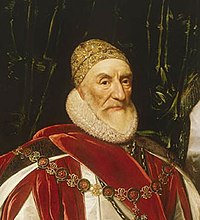Capture of Cádiz
Despite its failure in its primary objective of seizing the Spanish treasure fleet's silver, the raid contributed to Spain's declaration of bankruptcy the following year.[9] These forces were joined by another 20 ships from the United Provinces, with 2,000 men on board, who under the command of Admiral John de Duyvenvoorde, Lord of Warmond, were put under English orders.Juan Portocarrero and Alonso de Bazán weighed anchor in front of the Spanish galleys, intending to prevent the Anglo-Dutch fleet from passing into the interior of the bay.[9] The defensive tactics had to be improvised by Captain Pedro de Guía, the Mayor of Cádiz Antonio Girón, and the Duke of Medina-Sidonia in Jerez.(Lope de Valenzuela)[9] Before it was possible for the English forces to capture the Spanish fleet taking refuge in Puerto Real, Medina-Sidonia ordered its destruction.In guarantee of payment of the agreed-on ransom, various prominent citizens of the city were kept as hostages, including the president of the Casa de Contratación, the mayor, council members, and religious figures.The Earl of Essex, Francis Vere and the Dutch commanders demonstrated support for keeping the city in Anglo-Dutch hands, provisioning and garrisoning it for use as a base of operations.The economic losses produced by the Earl of Essex's expedition against the city and the anchored fleet in the port, estimated at 5 million ducats,[2] contributed to the bankruptcy of the royal treasury that same year.[9] After the departure of the English and Dutch, the Spanish authorities considered the possibility of fortifying the city or dismantling it and relocating it to Puerto de Santa María.




Battle of CádizAnglo–Spanish War (1585)Bay of CádizEnglandUnited ProvincesAlonso PérezAlonso de BazánCharles HowardRobert DevereuxJacob van DuivenvoordeWalter RaleighFrancis VereAnglo-Spanish War (1585–1604)San Juan de UlúaDrake's 1572-73 expeditionDrake's circumnavigationSão VicenteSanto DomingoCartagenaSt. AugustineCavendish's circumnavigationSpanish West IndiesHavanaHispaniola · Bay of Honduras1st Puerto CaballosSan MateoRecifeTrinidad · OrinocoLa Guaira · Caracas · CoroGuadalupe1st San JuanPanama2nd San JuanTabascoPortobello2nd Puerto CaballosSantiago de CubaVila Franca do CampoTerceiraNewfoundlandBermudaSantiago1st Azores1st Flores2nd FloresLas Palmas2nd AzoresScheldtPantelleria1st Cádiz ·AlgarveSpanish Armada (1st Calais · Gravelines)English Armada (Corunna · Lisbon)Bayona1st Gibraltar Strait2nd Gibraltar StraitBerlengasGulf of AlmeríaBarbary CoastBay of BiscayMount's BayCawsandCape FinisterreCornwall · West WalesSesimbraDover StraitGulf of CádizMiddelburgHaarlem1st GeertruidenbergLeidenValkenburgSchoonhovenGemblouxRijmenamBorgerhoutMechelen1st SteenwijkKollumNoordhornNiezijlLochemEindhovenSteenbergenAntwerpArnhem1st Grave1st Rheinberg1st Zutphen1st SluisBergen op Zoom2nd Geertruidenberg2nd ZutphenDeventerDelfzijlKnodsenburg1st HulstNijmegen2nd Steenwijk1st Coevorden3rd Geertruidenberg2nd CoevordenGroningen1st Groenlo2nd HulstTurnhout2nd Rheinberg2nd GroenloBredevoortEnschedeOotmarsumOldenzaalLingenSchenckenschansZaltbommelSan AndreasNieuwpoort3rd Rheinberg · 2nd MeursOstend's-Hertogenbosch2nd GraveArdenburg · Oostberg · 2nd SluisArquesChâteau-LaudranCaudebecMorlaixCrozon

